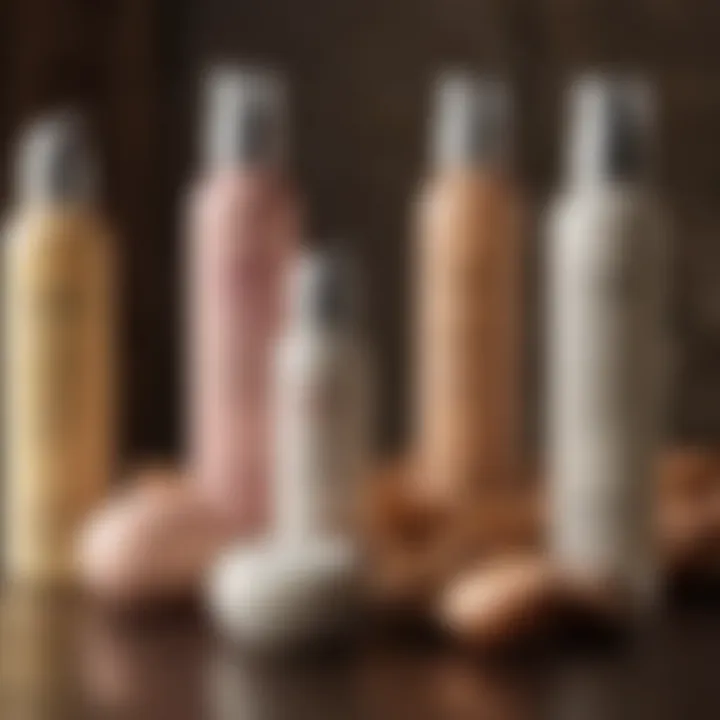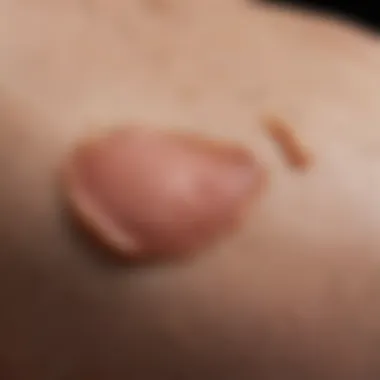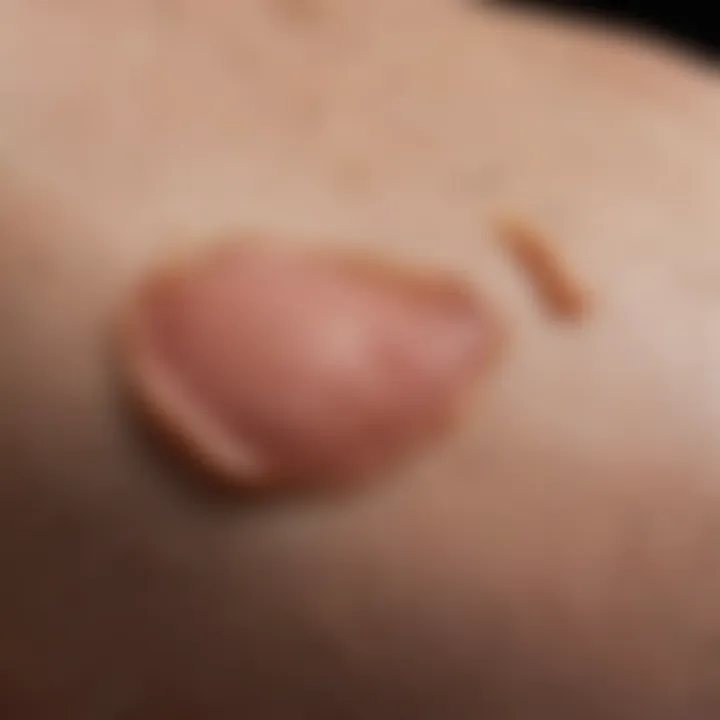Top Lotions to Treat Chicken Skin Effectively


Intro
Keratosis pilaris, often termed chicken skin, is a common yet often misunderstood skin condition that affects countless individuals. It typically manifests as tiny, rough bumps on the skin, most frequently seen on the arms, thighs, and cheeks. While it is largely harmless, these bumps can feel more like a nuisance than a mere cosmetic issue.
The appearance and texture of keratosis pilaris stem from the buildup of keratin, a protein that protects our skin and hair. Factors like genetics and dry skin can play a considerable part in the pronounced sensation of this condition.
Choosing the right lotion is crucial to managing chicken skin effectively. The right product can soothe irritation, improve texture, and bring relief to the affected areas. Rather than opting for just any moisturizer, understanding what ingredients and formulations work best is key. This article will take you through the essential elements of finding the best lotions particularly formulated to combat chicken skin, focusing on hydration and gentle exfoliation.
Whether you’ve been dealing with keratosis pilaris for years or have just found out about it, this guide offers insights designed to help you navigate the world of lotions.
"The skin is a mirror reflecting our overall health; taking care of it is not just skin-deep."
In the following sections, we will explore the key trends in skincare, essential tips for effective application, and much more that will arm you with the tools needed for smoother skin.
Understanding Chicken Skin
Understanding chicken skin, scientifically known as keratosis pilaris, is crucial for anyone grappling with this common skin condition. It often appears as small, rough bumps that crop up on the arms, thighs, and sometimes even the face. Many people dismiss it as merely a cosmetic nuisance, yet it can have a profound impact on self-esteem. By delving into the specifics of chicken skin, we can illuminate the importance of proper skincare and demystify the factors that contribute to it.
Defining Keratosis Pilaris
Keratosis pilaris manifests as tiny, raised bumps that resemble goosebumps or sandpaper texture. These bumps are actually clogged hair follicles, filled with keratin, a protein that protects skin from infections. When keratin builds up but cannot shed properly, it creates those unsightly bumps. To put it simply, it’s like a traffic jam on the skin's surface, where the skin cells fail to move along smoothly. Most often, this condition does not pose any health risks—it’s more of an aesthetic issue. For those living with keratosis pilaris, knowing what it is can be the first step towards seeking effective treatment and comfortable skincare.
Causes and Contributing Factors
So what causes this pesky condition? Surprisingly, the exact origin of keratosis pilaris remains somewhat murky. However, several key factors seem to play a role:
- Genetics: If your family tree is dotted with people who have chicken skin, there’s a good chance you might have inherited it.
- Dry Skin: Those colder months or an excessively dry climate can exacerbate the appearance of keratosis pilaris.
- Hormonal Changes: Life events like puberty or pregnancy can also influence skin texture.
- Skin Type: Individuals with thicker skin types may see more noticeable bumps.
Being informed about these contributing elements can make a difference in managing the condition effectively.
Common Misconceptions
There are numerous myths swirling around keratosis pilaris that can lead to confusion or misguided actions:
- Misconception 1: "It’s contagious."
- Misconception 2: "It only affects specific skin tones."
- Misconception 3: "It represents poor hygiene."
- In actuality, keratosis pilaris is entirely non-contagious. It won’t spread from person to person.
- This condition can show up on any skin tone, though its visibility may vary depending on one’s natural pigmentation.
- Some associate chicken skin with cleanliness, but this condition is rooted in genetics and skin behavior, not your bathing habits.
Clearing up these myths is important for anyone struggling with self-image due to keratosis pilaris. By fostering a better understanding of the condition, women of all ages can approach skincare with more knowledge and confidence.
Importance of Moisturization
Moisturization holds a key position in the skincare journey, especially for those dealing with keratosis pilaris, often referred to as chicken skin. This skin condition, characterizes by small, rough bumps, often forms when hair follicles become clogged with keratin. If not addressed properly, these bumps can become more pronounced, leading to discomfort and self-consciousness. That's where the power of moisturizers comes into play.
An effective moisturizer serves multiple purposes. It not only hydrates the skin but also creates a barrier that shields against environmental stressors. Hydrated skin is flexible, resilient, and less prone to irritation, which can aggravate keratosis pilaris. Regularly incorporating moisturization in your routine can significantly soften the skin's surface, helping to diminish the appearance of those pesky bumps. In many ways, moisturizing acts as a daily armor, protecting the skin while simultaneously promoting healing and improvement.
In addition, moisturizers can aid in enhancing the effectiveness of other treatment options. When skin is well-hydrated, treatments that involve exfoliation or other therapeutic components are generally absorbed better, making them more effective. Since keratosis pilaris can be stubborn, this synergy between hydration and active ingredients becomes crucial.
"Moisturization is not just a routine; it’s a ritual that supports skin health and revitalization."
How Moisturizers Contribute to Skin Health
Moisturizers play a fundamental role in maintaining skin health for individuals with keratosis pilaris. They function to restore balance and impede excessive dryness, which can exacerbate the appearance of bumps. The natural oils in our skin can diminish due to various factors—climate, hormonal changes, or even dietary habits. Thus, applying a quality moisturizer helps replenish what’s lost.
Moreover, moisturizer formulations often contain ingredients designed to provide skin-smoothing benefits, making rough patches look less pronounced. Ingredients like urea, known for its exfoliating properties, or hyaluronic acid, which attracts moisture to the skin, reinforce the skin's hydration levels, further supporting its natural functions. For many, this can lead to an overall improved skin texture over time.
Recommended Hydration Techniques
Incorporating effective hydration techniques can significantly influence the results achieved in managing keratosis pilaris. Here are some strategies to get the best out of your moisturizing efforts:
- Apply on Damp Skin: Right after showering or washing your face, apply your moisturizer while the skin is still damp. This creates a seal that locks in moisture.
- Choose the Right Ingredient Mix: Look for lotions containing a mix of humectants (like glycerin or hyaluronic acid) and occlusives (such as shea butter or cocoa butter) to ensure maximum hydration.
- Limit Hot Showers: Although tempting, prolonged hot showers tend to strip moisture from the skin. Opt for lukewarm water instead.
- Use a Humidifier: In dry climates or during winter months, using a humidifier can maintain air moisture levels, benefiting your skin.
- Stay Hydrated: Drinking adequate water is essential. Hydration from within complements topical treatments.


By implementing these techniques, you can ensure that your skin receives the hydration it craves, which is essential for managing chicken skin effectively.
Key Ingredients to Look For
Choosing the right lotion for chicken skin hinges on understanding the essential ingredients that contribute to alleviating this condition. Simply put, the right components can make a world of difference, transforming textured skin into something smoother and more even-toned. When picking a moisturizer, one should look for exfoliating agents, hydrating components, and soothing additives. Each group plays a significant role in how effectively a lotion can combat keratosis pilaris.
Exfoliating Agents
Alpha Hydroxy Acids
Alpha Hydroxy Acids, or AHAs, are a critical ingredient in skincare, particularly for chicken skin. These naturally occurring acids, often derived from fruits, work wonders in shedding dead skin cells. The primary characteristic that makes AHAs shine is their ability to enhance skin texture through exfoliation. Using AHAs can help thicken the skin's moisture barrier, which can lead to a smoother surface.
Unique to AHAs is their water-soluble nature, meaning they hydrate as they exfoliate. One must consider, however, that while effective, AHAs can sometimes irritate sensitive skin if overused. Gradual introduction and patch testing are advised here.
Beta Hydroxy Acids
Moving on, Beta Hydroxy Acids, known as BHAs, take a starring role in the realm of skincare. In contrast to AHAs, BHAs, such as salicylic acid, are oil-soluble. This characteristic allows them to penetrate deeper into the pores, making them an excellent option for those dealing with clogged hair follicles and bumpy skin.
What makes BHAs particularly beneficial for chicken skin is their dual exfoliating ability, targeting both the surface and within the skin. Despite their prowess, it's crucial to use them in moderation, as excessive use could lead to dryness or irritation.
Hydrating Components
Urea
Urea is an efficient humectant and plays a vital role in skin hydration. Its ability to draw moisture from the environment into the skin is a significant boon for anyone battling dry patches. Urea's keratolytic nature also helps thin out excess skin layers, contributing to a more refined appearance.
However, while it's a solid contributor to overall skin health, individuals with extremely sensitive skin must be cautious. High concentrations could lead to irritation, mainly if one isn't accustomed to using urea.
Glycerin
Another hallmark of moisturizers is glycerin. Known for its incredible moisture-retaining properties, glycerin effectively draws water into the skin, giving it a plump and hydrated look. It's often praised for feeling light on the skin, which makes it a popular choice among many.
Its consistency can create a barrier that protects the skin from moisture loss, so glycerin provides not just immediate hydration but also long-lasting effects. There are very few downsides, but those with oily skin may find formulations too heavy, thus leading to breakouts.
Hyaluronic Acid
Last but not least, Hyaluronic Acid is celebrated for its remarkable moisture retention, holding nearly a thousand times its weight in water. This property helps bring dry skin back to life, making it an excellent addition to any lotion meant for keratosis pilaris.
Yet, it’s essential to note that hyaluronic acid functions best in humid conditions; too dry an environment could lead to moisture being pulled from the skin, rather than into it. This duality presents an interesting conundrum for careful consideration.
Soothing Additives
Aloe Vera
Aloe Vera is a go-to for many requiring a cooling and soothing skin experience. Known for its anti-inflammatory properties, this ingredient can help mitigate any redness or irritation associated with chicken skin. Its lightweight gel consistency makes it easily absorbable, allowing for benefit with minimal greasiness.
On the downside, popularity sometimes breeds variability—some formulations may contain additives or preservatives that could irritate more sensitive skin types. Always check labels before diving in.
Shea Butter
On to Shea Butter—this rich emollient is known for its nourishing qualities. It hydrates and restores a natural glow to the skin while also contributing to its overall elasticity. The thick consistency provides a protective layer that shields the skin against environmental aggressors.
However, it can be on the heavy side. Those with oily or acne-prone skin should approach with caution, as it could exacerbate greasy skin conditions.
Chamomile
Chamomile is another soothing additive, recognized for its calming effects on the skin. This herb can help reduce irritation and redness tied to keratosis pilaris, making it particularly attractive for sensitive skin types. One characteristic that stands out is its natural anti-inflammatory and antioxidant attributes, which help with skin regeneration.
As a note of caution, some may experience allergic reactions, especially if they're sensitive to plants in the daisy family, of which chamomile is a member. Always proceed slowly and observe how the skin reacts.
Each of these ingredients offers its unique strengths and considerations; understanding them is crucial when sorting through options in the quest for smoother skin. Finding the right product that incorporates these elements can lead you to effectively manage chicken skin.
Top Lotions for Chicken Skin
Tackling chicken skin, or keratosis pilaris, can feel like an uphill battle without knowing the right products to use. It’s not just about choosing any lotion off the shelf; one must consider the particularities involved in treating this skin condition. The lotions that can truly make a difference often contain specific active ingredients that hydrate, exfoliate, and soothe the skin. Selecting the right formulation can significantly improve the skin’s texture and keep those pesky bumps at bay. This section emphasizes the importance of understanding your options when it comes to viable treatments.


Clinical Recommendations
When it comes to clinical insights, dermatologists often suggest lotions that incorporate active ingredients known to help improve keratosis pilaris. Clinical recommendations focus on formulations that provide a potent combination of exfoliating properties and hydration.
- Lotions high in urea are commonly advised by skin specialists due to its hygroscopic nature, meaning it attracts and retains moisture. This can lead to softer skin over time.
- Atypical options like retinoid creams also pop up in conversations. They work by prompting cell turnover, effectively reducing those unsightly bumps.
- Lactic Acid formulations can provide gentle exfoliation while also moisturizing, which makes them a popular choice.
It's always best to consult with a dermatologist, especially if the symptoms worsen. They can provide tailored recommendations suited for your specific skin type.
Over-the-Counter Options
For a more accessible route, over-the-counter lotions can be just what the doctor ordered. These products, available at local drugstores or even online, offer varying degrees of effectiveness without requiring a prescription.
Here are some widely recognized options:
- CeraVe SA Lotion for Rough & Bumpy Skin: This lotion includes salicylic acid and ceramides, promoting gentle exfoliation and helping restore your skin's barrier.
- Eucerin Roughness Relief Cream: With urea as a key ingredient, this cream deeply moisturizes while smoothing out texture.
- AmLactin Daily Moisturizing Body Lotion: Renowned for containing lactic acid, it ability to lock in moisture and relieve dryness makes it a tried and tested favorite.
These lotions are an economical step to enhancing skin health without jumping through hoops, making them viable options for those with chicken skin.
Natural Remedies
Natural remedies are gaining traction among those who prefer to steer clear of chemicals. While these may require a bit more time and patience, some users find significant improvements using home remedies or natural products.
- Coconut Oil: This often-hyped remedy relaxes the skin while its antimicrobial properties can be beneficial.
- Apple Cider Vinegar: It is touted for its ability to exfoliate, but be cautious. Always dilute it before applying to avoid irritation.
- Sugar Scrubs: A simple recipe of sugar and olive oil could help physically exfoliate the bumps when used regularly.
Remember, though, everyone’s skin is unique, so what works wonders for some may not work the same for others.
It's essential to test a small patch of skin before fully committing to any new product, whether it’s over-the-counter, clinical, or natural.
In summary, the realm of lotions offers a plethora of choices, each with their own strengths and weaknesses. The importance of understanding these options cannot be overstated, as it can genuinely play a role in achieving smoother, healthier skin for those dealing with chicken skin.
Product Application Techniques
Understanding how to apply lotion effectively is just as vital as choosing the right product, especially when dealing with chicken skin, or keratosis pilaris. Proper application techniques can enhance the benefits of any lotion, facilitating better absorption and maximizing moisture retention. When skin is properly prepared and the product is applied correctly, the chances of achieving smoother skin increase significantly.
Best Practices for Application
Achieving optimal results with your lotion hinges on how you apply it. Here are some best practices to consider:
- Cleanse First: Always start with clean skin. Washing the area gently with a non-irritating cleanser helps to remove dirt and oil, creating a clean canvas for the lotion to work its magic.
- Pat, Don’t Rub: After cleansing, pat the area dry with a soft towel instead of rubbing. This gentle approach prevents unnecessary irritation, allowing the skin to better absorb the lotion.
- Apply on Damp Skin: Applying lotion to slightly damp skin can boost its effectiveness. The moisture left on your skin helps to seal in hydration, making your lotion more effective at combating dryness.
- Use Enough Product: Don't shy away from using a generous amount. A small dollop won’t cut it. Ensure the area is evenly and adequately covered without skipping patches.
- Massage It In: Take a few moments to massage the lotion into your skin. This not only improves circulation but also encourages deeper penetration of the product into the skin layers.
"A little effort in how you apply lotion can make a world of difference for managing chicken skin."
- Be Gentle: Particular care should be taken not to scrub too vigorously, as keratosis pilaris-sensitive skin can be easily irritated.
Frequency and Timing
The impact of lotion can also be influenced by how often and when you apply it. Regularity is a key factor in seeing significant improvements.
- Daily Application: For best results, lotion should be applied at least once a day. Consistency helps in maintaining moisture levels and combating roughness associated with chicken skin.
- Morning vs. Evening: Many individuals find it beneficial to apply lotion immediately after their morning and evening showers. This is when the skin is clean and slightly damp, optimizing absorption.
- Layering Other Products: If using exfoliating products, such as those containing alpha or beta hydroxy acids, consider applying lotion afterward. This can help mitigate potential dryness from exfoliation while enhancing overall skin texture.
- Listen to Your Skin: Each person's skin reacts differently, so pay attention to how your skin feels. If it needs more hydration, don’t hesitate to apply additional lotion throughout the day.
By integrating these application techniques into your routine, you'll likely notice a marked improvement in the condition of your skin, which is the ultimate goal of using lotion to tackle keratosis pilaris.
Maintaining Skin Care Routine
A consistent skin care routine is more than just a chore; it's an essential element in the battle against chicken skin, or keratosis pilaris. For anyone seeking smoother skin, integrating a well-structured regimen can be a game changer. Regular attention to the skin helps to minimize the appearance of those pesky bumps, providing a pathway to confidence and comfort.
Integrating Exfoliation
Exfoliation is the unsung hero in the quest for revitalized skin. By removing dead skin cells, exfoliating products can significantly lessen the clogs that lead to those annoying bumps. But there's a fine line to walk here. Over-exfoliating can bring more harm than good, leaving your skin irritated and vulnerable. A balance of both physical exfoliants, like scrubs, and chemical exfoliants, such as alpha and beta hydroxy acids, is advisable. How often should one exfoliate? A good rule of thumb might be twice weekly, although individual skin types might necessitate adjustments.
- Gentle scrubs: Look for those with fine particles to avoid damage.
- Chemical exfoliants: Products containing glycolic or salicylic acid can provide effective results without the abrasive touch.
- Be mindful: Always listen to your skin. If irritation occurs, scale back your exfoliation frequency.
It might be worth mentioning that integrating exfoliation doesn't mean emptying your wallet. Many drugstore options are as effective as their high-end counterparts, so don’t feel pressured to overspend.
Recognizing Results and Adjusting Routine


Setting out on a journey towards smoother skin isn’t always straightforward. It takes patience, and more importantly, keen observation. As you incorporate lotions and undergo exfoliation, it’s crucial to monitor how your skin responds. Does the lotion seem to be working? Are the bumps diminishing or becoming more pronounced? Keeping a simple skin journal can be beneficial to track your progress—note any changes, reactions, and improvements over time.
The process of recognizing results also ties into being flexible. If a product isn't performing as expected after a reasonable time, it may be necessary to rethink your choices. Switching to a different lotion or altering the application technique could be the key to finding what works best for your skin.
"Adaptability is about the relentless pursuit of finding what best suits your unique skin needs."
In summary, maintaining a skin care routine isn’t a one-size-fits-all; it’s a dynamic process that involves a fair bit of trial and error. As you embark on this journey, stay flexible and don’t hesitate to adjust course based on what your skin tells you.
Reviewing User Experiences
When it comes to selecting a lotion for chicken skin, also known as keratosis pilaris, diving into user experiences can be invaluable. Real-world accounts provide insight that clinical studies sometimes overlook. Such testimonials can illuminate how products perform on different skin types, highlight specific benefits, and draw attention to any drawbacks that might not be immediately apparent from marketing materials.
Real-Life Testimonials
User testimonials often paint a vivid picture of the effectiveness of various lotions. For example, a woman named Sarah found great relief using CeraVe SA Lotion for Rough & Bumpy Skin. She mentioned, "I've struggled with keratosis pilaris for years but after using this lotion for a few weeks, I noticed a significant difference in the texture of my skin. It feels smoother and less bumpy!" On the other hand, another user, Lisa, had an opposite experience with a popular natural remedy that she heard about from a friend. "I tried using coconut oil, but it just clogged my pores and made things worse," she explained. This contrasting feedback emphasizes the importance of testing a product to see how it works individually.
From social media platforms, like Reddit, you can find numerous discussions where users share their encounters with keratosis pilaris treatments. Some users commend lotions containing glycolic acid, while others swear by those enriched with shea butter, pointing to the diversity in preferences and skin responses. Thus, while some users rave about a particular formulation, others might find it ineffective. This variety of experiences underscores the need for personalized approaches when searching for a solution.
Expert Insights
Expert opinions can further shape our understanding of personal experiences. Dermatologists often recommend specific products based on clinical evidence and professional patient feedback. For instance, Dr. Jane Smith, a dermatology expert, frequently advises her patients to try lotions with exfoliating ingredients. "Products with lactic acid or salicylic acid are beneficial, as they help remove the build-up of keratin that causes chicken skin," she notes. Dr. Smith elaborates that the right formulation can mean the difference between feeling self-conscious and confident.
Moreover, seeking advice from professionals can help avoid common pitfalls. Experts can guide users on how to combine different treatments effectively and educate them about potential side effects. Surprisingly, many persistent users might overlook how important proper application techniques can be. Adherence to recommendations boosts the efficacy of any lotion.
"Always remember, what works for one person might not work for another. Everyone’s skin is unique." - Dr. Jane Smith
Ultimately, the collective knowledge found in both user testimonials and expert insights serves as a compass in the often complicated journey toward smoother skin. By weighing both perspectives, individuals are better armed to make informed decisions in their quest.
Professional Advice and Consultation
Seeking professional advice is a critical step in addressing keratosis pilaris, or chicken skin. This condition, while often harmless, can cause significant discomfort or concern for many. Therefore, understanding when and why to consult a dermatologist can be instrumental in managing skin health effectively.
When to Seek Dermatological Help
If your chicken skin persists despite your best efforts with over-the-counter remedies, it may be time to consult a specialist. Here are some signs indicating that a visit to the dermatologist is in order:
- Redness and Inflammation: If the skin surrounding the bumps becomes increasingly red or inflamed, this could signal an infection or irritation requiring professional evaluation.
- Severe Itchiness or Pain: If the condition causes severe discomfort, itchiness, or pain, it’s advised to seek expert opinion.
- No Improvement: When lotions and home remedies just aren’t cutting it, don’t hesitate to reach out for help. Everyone’s skin responds differently, and a dermatologist can offer tailored solutions.
- Skin Changes: Any new growth or changes in the appearance of your skin warrant a visit.
Consulting a professional gives the opportunity not only to understand personal skin needs but also to gain insight into the most effective treatments available.
Potential Treatments Beyond Lotion
Lotion is not the only player in the game against keratosis pilaris. In fact, a variety of treatments could complement or even replace topical options. Consider these approaches that dermatologists might suggest:
- Prescription Creams: Many dermatologists prescribe potent retinoid creams to help unclog hair follicles. These formulations often contain higher concentrations of exfoliating agents.
- Laser Therapy: For stubborn cases, laser treatments can effectively target chicken skin by reducing the redness and promoting smoothness. This might involve a few sessions, but can yield lasting results.
- Chemical Peels: A professional chemical peel can help shed the upper layer of dead skin cells, providing a fresher skin surface. This is a more intensive treatment that requires downtime, so it's best to discuss with a dermatologist.
- Microdermabrasion: This procedure removes the outer layer of skin through exfoliation, improving the texture of the area affected by keratosis pilaris and promoting healthier skin growth.
By exploring these treatments, individuals can find strategies to effectively manage chicken skin and improve their overall skin health.
"Seeking professional advice early can often lead to quicker resolution and more effective treatment plans for skin conditions like keratosis pilaris."
Employing both topical and professional treatments can create a holistic approach, allowing for greater customization to individual skin needs. The key is to remain proactive in addressing the condition and find what works best through open dialogue with a healthcare provider.
Ending and Summary
In wrapping up our discussion on managing chicken skin, or keratosis pilaris, it becomes clear that this is not merely a superficial concern. The journey towards achieving smoother skin entails understanding the condition, the importance of hydration, and the selection of appropriate products. While the list of recommended lotions is noteworthy, the underlying message emphasizes a holistic approach.
Firstly, it’s important to recognize that keratosis pilaris is common and affects many individuals. Hence, connecting with others who share this experience can be beneficial. After all, knowing you're not alone can sometimes make a world of difference.
Hydration cannot be overstressed. Moisturizers do more than just slather on moisture; they actively contribute to skin health by creating a barrier that locks in hydration and promotes healing. Women of all ages can benefit from understanding how to incorporate creams rich in alpha and beta hydroxy acids into their routine—these exfoliating agents are game-changers when it comes to smoothing rough patches.
Moreover, one needs to consider the individual’s skin type and preferences when selecting lotions. Not every lotion will work for everyone. Personalization is key. Some may prefer a lightweight gel, while others might favor a richer cream. The effectiveness of a product is often tied not just to its ingredients but also to how one feels using it. And don’t forget, consistency is your best friend here; make moisturizing a daily habit to see the best results.
"Moisturizing isn’t just about tackling the stubborn bumps; it’s about embracing the journey toward healthier skin."
Lastly, seeking professional advice is not a sign of defeat, but rather an empowering choice. Visiting a dermatologist can provide personalized insights that over-the-counter solutions might not cover. Consultations can illuminate the potential treatments beyond lotion, ensuring a path that is tailored to one’s unique needs.
Final Thoughts on Effective Choices
When it comes to selecting the right lotion for chicken skin, there are several key considerations worth keeping in mind:
- Key Ingredients: Look for lotions that contain exfoliating agents, hydrating components, and soothing additives. The right combination can enhance texture and hydration without irritation.
- Skin Type Compatibility: It's crucial to choose a product that matches your skin type. Consider whether your skin leans more towards oily, dry, or a combination.
- Lifestyle Integration: Think about how a product will fit into your daily routine. A lotion that is easy to use consistently will likely yield better results than one that feels cumbersome or greasy.
- User Feedback: Explore real-life testimonials and expert reviews to gauge the effectiveness of various products. Hearing from those who’ve walked the path can provide invaluable insights.
Ultimately, the journey to managing chicken skin is not a sprint but a marathon. With patience, persistence, and the right lotion, smoother skin can be within reach.



